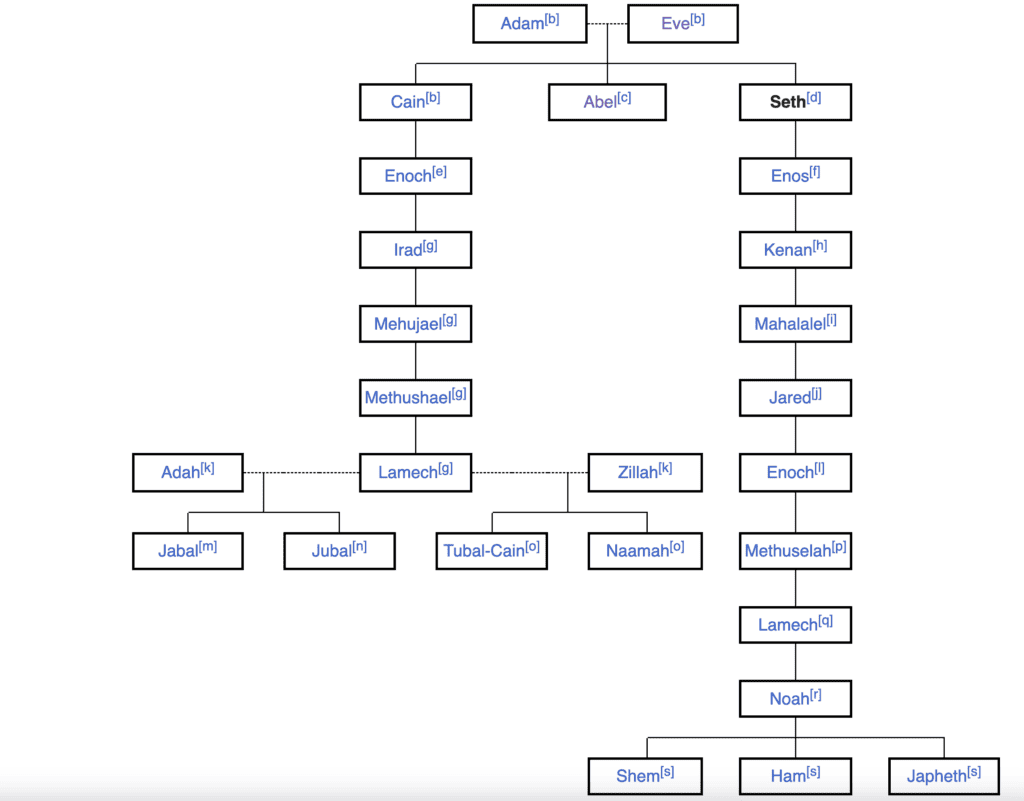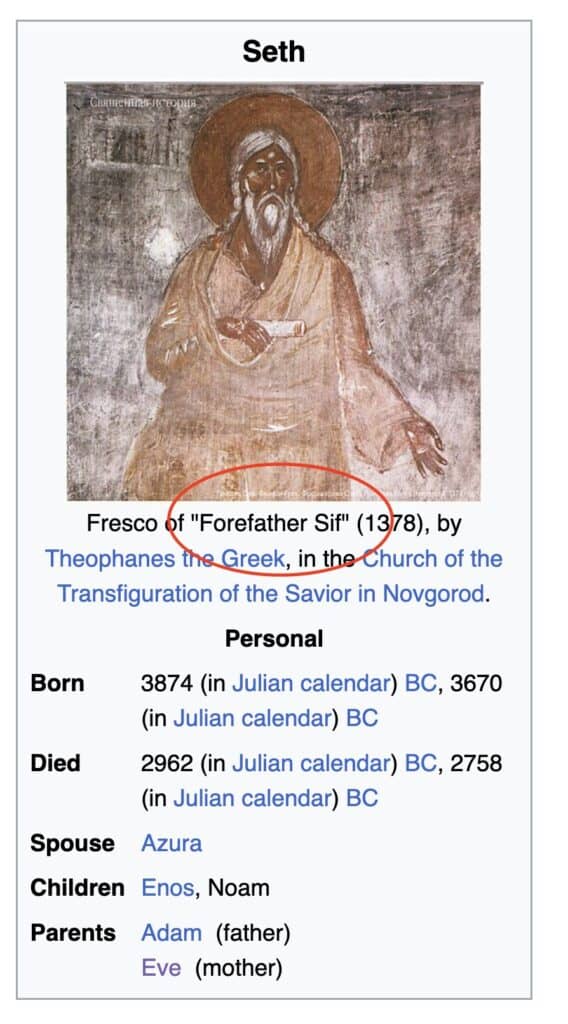Table of Contents

Abel’s soul passed into Seth and later into Moses
Names:
- שת
- Šet
- Set
- شيث Shith or Shiyth
Biblical:
Seth died at the age of 912
Adam gave Seth secret teachings that would become the Kabbalah.
In the Abrahamic religions, Seth was the third son of Adam and Eve. According to the Hebrew Bible, he had two brothers: Cain and Abel.
According to Genesis 4:25, Seth was born after Abel’s murder by Cain, and Eve believed that God had appointed him as a replacement for Abel. He is the only other child of Adam and Eve named in the Bible.
The Zohar refers to Seth as “ancestor of all the generations of the Egyptians or Tsetsaudim”
According to Seder Olam Rabbah, based on Jewish reckoning, he was born in 2130 BC AM. According to Aggadah, he had 2 sons and many wives. According to the Seder Olam Rabbah, he died in 1042 AM
In the Antiquities of the Jews, Josephus refers to Seth as virtuous and of excellent character,[8] and reports that his descendants invented the wisdom of the heavenly bodies, and built the “pillars of the sons of Seth“, two pillars inscribed with many scientific discoveries and inventions, notably in astronomy.
Within Islamic tradition Seth holds wisdom of several kinds; knowledge of time, prophecy of the future Great Flood, and inspiration on the methods of night prayer.
According to Yazidi oral literature, Adam and Eve each deposited their seeds into separate jars. While Eve’s seed developed into insects, Adam’s seed gave birth to Shehid ibn Jerr, the ancestor of the Yazidis. Yazidis thus believe that they have been created separately and differently from all other human beings.
According to it, in 231 AM Seth married his sister, Azura, who was four years younger than he was. In the year 235 AM, Azura gave birth to Enos.
After Abel ‘s death, Seth is indicated as righteous by Judeo-Christian theology, in contrast to Cain. In the apocryphal book of Zohar 1:36b, Seth is called the ancestor of all generations of the righteous. According to the Book of Jubilees, also apocryphal, Seth married his younger sister Azura and had several children, including Enos and his daughter Hôh. In Islam, Seth is considered one of the Islamic prophets. source
The origin of the name ( שת ) is not clear, but it is assumed that it means named, because when she is born, Eve says: ” …God gave me ( שית ) another son in place of Abel; because Cain killed him.

Seth (Egyptian Mythology)
In ancient Egyptian religion, Seth is a god associated with chaos, violence, deserts, storms, and foreigners. He is often depicted as the antagonist of Osiris and Horus in the Egyptian pantheon, representing the opposite force to that of order and fertility.
Osiris
Osiris is one of the major gods in ancient Egyptian religion, commonly identified as the god of the afterlife, the underworld, and the dead. He is traditionally depicted as a green-skinned deity with pharaoh’s attributes, such as a false beard and a crown, and wrapped like a mummy. According to mythology, Osiris was a benevolent king of Egypt who was murdered and dismembered by his brother Seth, the god of chaos and destruction.
-Abel was murdered
Osiris’s wife, Isis, reassembled his body and resurrected him with the help of the god Anubis. Osiris then became the ruler of the underworld and a god symbolizing resurrection and eternal life.
Horus
Horus is the god of the sky, and is often depicted as a falcon or as a man with the head of a falcon. The most well-known legend involving Horus is his battle with Seth to avenge his father, Osiris’s death. Horus is typically portrayed as the son of Osiris and Isis. He fought a long and complicated series of battles with Seth, not only to avenge his father but to determine who would rule Egypt. This conflict is a central narrative in Egyptian mythology, symbolizing the eternal struggle between order (Horus) and chaos (Seth). Eventually, Horus is victorious, and this victory is seen as legitimizing the reigning pharaoh’s rule, with the pharaoh being considered the “living Horus.”
The relationship between Osiris and Horus, and their interconnected myths, were crucial to ancient Egyptian culture. They underscored the themes of legitimate kingship, justice, and the triumph of good over evil. Horus’s victory and subsequent rulership also symbolize the restoration of order after the disruptive rule of Seth.
Sif

In Norse mythology, Sif is a golden-haired goddess associated with earth. Sif is attested in the Poetic Edda, compiled in the 13th century from earlier traditional sources, and the Prose Edda, written in the 13th century by Snorri Sturluson, and in the poetry of skalds. In both the Poetic Edda and the Prose Edda, she is known for her golden hair and is married to the thunder god Thor.
Then Sif went forward and poured out mead for Loki into a crystal cup and said:
Stanzas 53 and 54 of the poem Lokasenna
Welcome now, Loki, and take the crystal cup
full of ancient mead,
you should admit, that of the children of the Æsir,
that I alone am blameless.
Sethianism
The Sethians (Greek: Σηθιανοί) were one of the main currents of Gnosticism during the 2nd and 3rd century AD, along with Valentinianism and Basilideanism.
According to Epiphanius of Salamis (c. 375), Sethians were in his time found only in Egypt and Palestine, but fifty years earlier, they had been found as far away as Greater Armenia.
From the “Unknown God” emanate aeons, a series of paired female and male beings. The first of these is Barbelo, who is coactor in the emanations that follow. The aeons that result are representative of the various attributes of God, which are indiscernible when they are not abstracted from their origin. God and the aeons comprise the sum total of the spiritual universe, known as the Pleroma.
In some versions of the myth, the Aeon Sophia imitates God’s actions, performing an emanation of her own, without the prior approval of the other aeons in the Pleroma. This results in a crisis within the Pleroma, leading to the appearance of the Yaldabaoth, a “serpent with a lion’s head“. This figure is commonly known as the demiurge, the “artisan” or “craftsman”, after the figure in Plato’s Timaeus.[note 6] This being is at first hidden by Sophia but subsequently escapes, stealing a portion of divine power from her in the process.
Using this stolen power, Yaldabaoth creates a material world in imitation of the divine Pleroma. To complete this task, he spawns a group of entities known collectively as Archons, “petty rulers” and craftsmen of the physical world. Like him, they are commonly depicted as zoomorphic, having the heads of animals. Some texts explicitly identify the Archons with the fallen angels described in the Enoch tradition in Judaic apocrypha.
At this point the events of the Sethian narrative begin to cohere with the events of Genesis, with the demiurge and his archontic cohorts fulfilling the role of the creator. As in Genesis, the demiurge declares himself to be the only god, and that none exist superior to him. However, the audience’s knowledge of what has gone before casts this statement, and the nature of the creator itself, in a radically different light.
The demiurge creates Adam, during the process unwittingly transferring the portion of power stolen from Sophia into the first physical human body. He then creates Eve from Adam’s rib, in an attempt to isolate and regain the power he has lost. By way of this he attempts to rape Eve who now contains Sophia’s divine power; several texts depict him as failing when Sophia’s spirit transplants itself into the Tree of Knowledge. Thereafter, the pair are “tempted” by the serpent, and eat of the forbidden fruit, thereby once more regaining the power that the demiurge had stolen.
From the Gospel of the Egyptians
Then the great Seth, the son of the incorruptible man Adamas, gave praise to the great, invisible, uncallable, unnameable, virginal Spirit, and the <male virgin, and the thrice-male child, and the male> virgin Youel, and Esephech, the holder of glory and the crown of his glory, the child of the child, and the great Doxomedon-aeons, and the pleroma which I mentioned before; and asked for his seed.
The Gospel of the Egyptians
Then the great angel Hormos came to prepare, through the virgins of the corrupted sowing of this aeon, in a Logos-begotten, holy vessel, through the holy Spirit, the seed of the great Seth.
Then the great Seth came and brought his seed. And it was sown in the aeons which had been brought forth, their number being the amount of Sodom. Some say that Sodom is the place of pasture of the great Seth, which is Gomorrah. But others (say) that the great Seth took his plant out of Gomorrah and planted it in the second place, to which he gave the name ‘Sodom’.
The Gospel of the Egyptians
Legends of Old Testament characters, from the Talmud and other sources
Summary of Seth’s Reign and Legacy
Seth’s Reign:
- Ascended the throne after Adam and was considered the greatest of Adam’s sons.
- Made annual pilgrimages to the Kaaba and ruled with equity, resulting in a flourishing world.
- Had a son named Enoch at age fifty and named him his executor. Seth died at the age of nine hundred.
Conflict with the Giants:
- Seth and his brothers waged continuous wars against the Divs (giants), descendants of Cain.
Rocail’s Mystical Knowledge:
- Rocail, another son of Adam, was known for his exceptional knowledge and was sent to assist Surkrag, a giant ruler.
- Before his death, Rocail built an elaborate sepulcher with animated, speaking statues.
Rabbinic Traditions and Lineage:
- Seth was one of thirteen born circumcised.
- It was believed Abel’s soul passed into Seth and later into Moses, ensuring the continuity of divine law.
- Seth received prophecies about the world’s future, including the Flood and the coming Messiah.
Marriage and Offspring:
- Married his sister, Azur (or Noræa or Horæa).
- His descendants were known as the “sons of God” due to Seth’s piety and divine attributes.
Discoveries and Legacy:
- Seth was credited with discovering Hebrew letters and the names of stars.
- Built two pillars inscribed with his knowledge to preserve it through the coming floods, one of brick and one of stone. The stone pillar survived into the time of Josephus.
Divine Favor and Attributes:
- Seth was believed to inherit the unfallen image of Adam, with a radiant, divine appearance.
- His wisdom and appearance led people to call him “God,” and his children were termed “sons of God.”
- Associated with resurrection and divine wisdom.
Historical and Mythical Connections:
- Seth was later equated with an ancient Egyptian deity, initially a giver of light and civilization but later associated with the adversary Typhon.
- Known for several apocryphal writings attributed to him.
